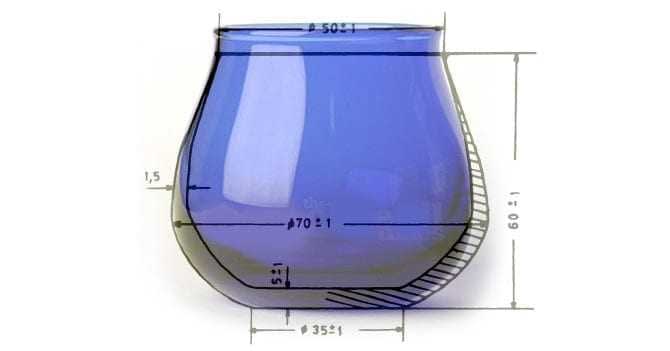Olive oil tasting needs to follow precise rules, and the use of the right tools. A famous cobalt blue glass is one of them.
According to the International Olive Oil Council, an official sensory analysis of olive oil requires a standard glass that has to match some specific and peculiar characteristics. The olive oil tasting glass standard, set in 1987, prescribes the glass for use in the “organoleptic analysis of edible oils.”
See Also:Buy olive oil tasting glassesEvery detail is specified, from its dimensions to the material and design. It has to be made of resistant glass, and it should be dark-colored so that the color of its contents cannot be examined, as this is not a relevant criteria for evaluation. It should be free from scratches or bubbles and the rim shall be even, smooth and flanged. It has to guarantee maximum steadiness, to prevent the glass from tilting and the oil from being spilled.
The larger base must easily fit the indentations of a heating unit — it is recommended that samples should be examined at 26 – 30ºC — and the glass has to be annealed so that it stands the temperature changes. It should also be perfectly cradled in one’s hand so that the bottom of the glass is kept evenly heated, while the narrow mouth guides the aromas and facilitates their identification.
Finally, each glass should be equipped with a watch-glass larger than the mouth of the glass (10 mm diameter), to prevent the loss of aroma and the intrusion of dust.

Italian glassmaking company Fara produces olive oil tasting glasses perfectly matching the COI standard. Though it never received official certification by the International Olive Council, their tasting glasses have been used by official tasting panels or tasting courses since their production started in 2006.
The Tuscan company, established 30 years ago not too far from Florence, is specialized in producing glassware and porcelain for hotels and restaurants. They also offer a range of exclusive mouth-blown items specifically designed and implemented for food service requirements, including the oil tasting glasses.
“During the last seven years,” says Francesco Caponi, Marketing Manager and son of one of the company’s founders, “demand for olive oil tasting glass has grown considerably. Since when we first launched it, the production shifted from 1,200 units in the first year (2007) to over 6,000 in 2011. For 2012 sales remained steady.”
The production process still has some handcrafting characteristics.
The molten glass crucible (at a temperature of 1,200 Celsius degrees) is put in a refractory pan. The master glazier extracts an incandescent glass ball using an appropriate metal stick. He then places it on a metal plate and starts to shape the glass. Once it has been sketched, but still in an uneven shape, the glass is inserted into a mold and the glazier blows in through the stick, to give all the glasses a similar shape, although no blown glass item is ever identical to another.
The artisan takes the shape out of the mold when it is still soft, and using tongs he cuts the glass still attached to the stick. Using a crack-off machine, he can cut the glass ball open, giving it the shape of a small glass. The oil tasting glass is now finished, but it sill needs to be annealed, that is to say to be put in a final furnace at a lower temperature, where the glass is allowed to slowly cool, to keep it from cracking from thermal stress.
Using the right glass is mandatory for certified tastings and evaluations, yet anyone who uses it once will easily understand that it is the best way to detect olive oil defects and undesirable flavors, as well as appreciate a good extra virgin olive oil’s aromas and fruitiness at its best, before adding it to any food.








